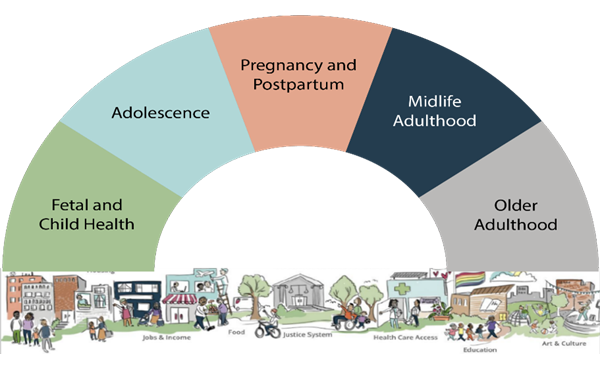Public Health Frameworks to Advance Healthy Aging
May 31, 2022

Graphic from Human Impact Partners, used with permission
What Is Healthy Aging?
CDC defines healthy aging as “the development and maintenance of optimal physical, mental (cognitive and emotional), spiritual, and social well-being and function in older adults.” To better support older adults, Healthy People 2030 outlines a goal to “improve health and well-being for older adults” by implementing 20 measurable objectives over the next decade.
As of 2016, 49 million adults in the United States were above the age of 65, representing 15% of the population. In 2030, this number is expected to reach 71 million. By 2060, adults over the age of 65 will exceed 98 million and represent 25% of the entire population. Disparities observed in older adulthood are a result of a lifetime of complex upstream factors that drive inequities seen in this growing population. By addressing the social determinants of health in early adulthood, we can mitigate these inequities and promote a higher quality of life for older adults.
Supporting Healthy Aging
ASTHO’s Healthy Aging Policy Statement supports healthy aging across the lifespan by recommending improvements to structural determinants of health, as well as to medical and social services that address healthy aging. ASTHO encourages state and territorial health agencies (S/THAs) to leverage the following frameworks to create an age-friendly environment conducive to improving quality of life across all ages. When considerations for health promotion and disease prevention planning are made for older adults, individuals across all ages and abilities benefit. The graphic above depicts what this new landscape could look like, as the social determinants of health are integrated across the life course. These frameworks can support creating a culture of healthy aging within public health.
Previous efforts to bring healthy aging to the forefront of public health can be seen in CDC’s Healthy Aging In Action report. The report highlights three areas that S/THAs can prioritize to promote healthy aging and increase the proportion of Americans who are healthy at each stage of life. These recommendations include health promotion, injury prevention, and chronic disease management along with another domain that emphasizes facilitation of social engagement, as well as a final domain focused on optimizing physical, cognitive, and mental health statuses of an individual. The following frameworks for healthy aging can support S/THAs in working toward these recommendations.
Trust for America’s Health Age-Friendly Public Health System
Trust for America’s Health (TFAH) developed the age-friendly public health system (AFPHS) framework, established in 2017, to promote physical, mental, emotional, and social well-being with the understanding that healthy aging is an adaptive process in response to challenges. It is also a proactive process that can reduce the effect of future challenges. The framework recommends six ways public health agencies can support healthy aging:
- Create and lead policy, systems, and environmental changes to improve older adult health and well-being.
- Connect and convene multi-sector stakeholders to better meet the health and social challenges of older adults.
- Coordinate existing supports and services to help older adults, families, and caregivers navigate and access services, avoid duplication, and promote an integrated system of care.
- Collect, analyze, and translate data on older adults to identify a community’s needs and assets, and inform the development of interventions through community-wide assessment.
- Communicate important public health information to promote and support older adult health and well-being, including disseminating research findings and emerging best practices to support healthy aging.
- Complement existing health promoting programs to ensure they meet the needs of older adults.
Health departments can work toward these recommendations to participate in the AFPHS Recognition Program to highlight their commitment to healthy aging.
AARP Age-Friendly Framework and Network
AARP’s Age-Friendly Framework, an affiliate of WHO, prioritizes eight domains of livability that cities, towns, counties, and states should highlight to make their jurisdictions suitable for living for older adults, as well as people of all ages. Established in 2012, these domains consist of housing, social participation, outdoors spaces and buildings, transportation, communication and information, civic participation and employment, respect and social inclusion, and health services and community support. Member communities can go through the following assessment process to become an age-friendly jurisdiction:
- Establish a way—through commission, advisory panel or focus groups – to include older residents in all stages of the age-friendly planning and implementation process.
- Conduct a community needs assessment, for which AARP provides survey examples, templates, and an online tool.
- Develop plans for action and evaluation based on assessment results, then submit to AARP for review.
- Implement and work toward the goals of the plan.
- Review and repeat progress and the cycle.
In addition to the above frameworks, S/THAs may also consider utilizing specifically tailored recommendations for supporting cognitive health as it relates to aging.
Memory loss is not a normal part of aging and is often a topic that comes to mind when thinking about older adult health. For specific information to support cognitive health as it relates to aging, S/THAs can access the CDC’s and Alzheimer’s Association’s Healthy Brain Initiative Road Map Series, which includes the State and Local Public Health Partnerships to Address Dementia: The 2018-2023 Road Map and utilizes the life course perspective to support S/THAs in improving population health outcomes, particularly around efforts regarding dementia including Alzheimer’s.
For more information and technical assistance, email ASTHO’s Health Improvement and Healthy Aging team at healthyaging@astho.org.